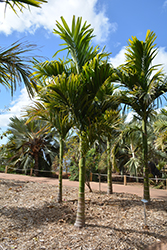Fri & Sat 8am - 8pm
Sun 8am - 7pm
Anytown, USA 12345
fax: 261.787.0463
e-mail: info@successgc.com


Plant Finder

Height: 40 feet
Spread: 9 feet
Sunlight:
![]()
![]()
Hardiness Zone: 10a
Other Names: Areca Palm, Areca Nut Palm, Betal Palm
Description:
A medium sized palm selection that features long, arching fronds and multi-branching, creamy white fragrant flowers; an a wonderful addition to landscapes and large indoor areas; produces small yellow-orange fruit with brown, oval seeds
Ornamental Features
Betal Tree has attractive forest green evergreen foliage on a tree with an upright spreading habit of growth. The large glossy narrow pinnately compound leaves are highly ornamental and remain forest green throughout the winter. It produces yellow berries with orange overtones in early fall.
Landscape Attributes
Betal Tree is an evergreen tree with a strong central leader and an upright spreading habit of growth. Its relatively coarse texture can be used to stand it apart from other landscape plants with finer foliage.
This is a relatively low maintenance tree, and should not require much pruning, except when necessary, such as to remove dieback. It has no significant negative characteristics.
Betal Tree is recommended for the following landscape applications;
- Accent
- Naturalizing And Woodland Gardens
Planting & Growing
Betal Tree will grow to be about 40 feet tall at maturity, with a spread of 9 feet. It has a low canopy with a typical clearance of 5 feet from the ground, and should not be planted underneath power lines. It grows at a slow rate, and under ideal conditions can be expected to live for approximately 20 years.
This tree does best in full sun to partial shade. It does best in average to evenly moist conditions, but will not tolerate standing water. It is not particular as to soil pH, but grows best in rich soils. It is somewhat tolerant of urban pollution. This species is not originally from North America.
